Practice the AP 8th Class Physical Science Bits with Answers Chapter 4 Synthetic Fibres and Plastics on a regular basis so that you can attempt exams with utmost confidence.
AP State Syllabus 8th Class Physical Science Bits 4th Lesson Synthetic Fibres and Plastics with Answers
Choose the correct answer.
Question 1.
………….. is not a natural fibre.
A) cotton
B) silk
C) wool
D) nylon
Answer:
D) nylon
Question 2.
………… is not a synthetic fibre.
A) polyester
B) cotton
C) nylon
D) acrylic
Answer:
B) cotton
![]()
Question 3.
Synthetic fibres are made of
A) polymers
B) monomers
C) both A & B
D) none of these
Answer:
A) polymers
Question 4.
………….. is a synthetic fibre, prepared from coal, water and air.
A) nylon
B) rayon
C) acrylic
D) polyester
Answer:
A) nylon
Question 5.
………… is used in making parachutes.
A) Rayon
B) Nylon
C) Plastic
D) None of these
Answer:
B) Nylon
Question 6.
The combination of two or more fibres is called
A) blending
B) bleeding
C) moulding
D) melting
Answer:
A) blending
![]()
Question 7.
…………. are poor conductors of heat and electricity.
A) Gold
B) Silver
C) Copper
D) Plastics
Answer:
D) Plastics
Question 8.
Rayon is prepared by
A) Coal
B) Oxygen
C) Fibre
D) Cellulose
Answer:
D) Cellulose
Question 9.
Labels on clothes are used because…
A) Required by law
B) To identify fabric content
C) Both A and B
D) They do not decompose
Answer:
C) Both A and B
Question 10.
The material which is not decomposed by natural process is called
A) Non-biodegradable material
B) Biodegradable material
C) Polyester
D) Nylon
Answer:
A) Non-biodegradable material
![]()
Question 11.
Which is a Natural fibre among the following?
A) Rayon
B) Nylon
C) Polyester
D) Silk
Answer:
D) Silk
Question 12.
………… is called fake fur.
A) Polyester
B) Nylon
C) Acrylic
D) Rayon
Answer:
C) Acrylic
Question 13.
Terylene is mixed with ………… to make terricot.
A) wool
B) silk
C) cotton
D) none of these
Answer:
C) cotton
Question 14.
PET bottles belongs to …………… plastic material.
A) Code 1
B) Code 2
C) Code 3
D) Code 4
Answer:
A) Code 1
![]()
Question 15.
…………… fibre is as strong as steel.
A) Rayon
B) Nylon
C) Polyester
D) Acrylic
Answer:
B) Nylon
Question 16.
The full form of PVC is
A) Poly Vinyl Chloride
B) Phenyl Vinyl Chloride
C) Poly Vinyl Chlorate
D) Poly Vinyl Chloric acid
Answer:
A) Poly Vinyl Chloride
Question 17.
The fibres which are obtained from plant and animal source are called
A) Artificial fibres
B) Synthetic fibres
C) Natural fibres
D) None of these
Answer:
C) Natural fibres
Question 18.
The fibres which are obtained from petroleum are called
i) artificial fibres
ii) synthetic fibres
iii) natural fibres
iv) man made fibres
A) i only
B) ii only
C) iii only
D) i, ii and iv
Answer:
D) i, ii and iv
![]()
Question 19.
………….. contain carbon, oxygen and nitrogen.
A) Polyester
B) Poly Vinyl Chloride
C) Polyethene
D) Polyamides
Answer:
D) Polyamides
Question 20.
……………. helps us to reduce the limitations of both fibres.
A) blending
B) moulding
C) melting
D) boiling
Answer:
A) blending
Question 21.
…………… is wrinkle free.
A) Wool
B) Cotton
C) Polyester
D) Silk
Answer:
C) Polyester
Question 22.
Example of thermosetting plastic is
A) Bakelite
B) Melamine
C) Polyethene
D) Both A & B
Answer:
D) Both A & B
![]()
Question 23.
Example of thermoplastic is
A) Bakelite
B) Polyethene
C) PVC
D) Both B & C
Answer:
D) Both B & C
Question 24.
Food material are
A) biodegradable
B) non-biodegradable
C) both
D) none
Answer:
A) biodegradable
Question 25.
Plastic is a
A) biodegradable
B) non-biodegradable
C) both
D) none
Answer:
B) non-biodegradable
Question 26.
Popular dress material is
A) silk
B) wool
C) cotton
D) polyester
Answer:
D) polyester
![]()
Question 27.
Artificial silk among these is
A) nylon
B) acrylic
C) rayon
D) silk
Answer:
C) rayon
Question 28.
This fibre is stronger than any other fibre
A) rayon
B) polyester
C) acrylic
D) nylon
Answer:
D) nylon
Question 29.
Which of the following is not a natural fibre?
A) Cotton
B) Wool
C) Jute
D) None
Answer:
D) None
Question 30.
Silk : animal:: nylon : ?
A) plant
B) animal
C) petrochemical
D) A or B
Answer:
C) petrochemical
![]()
Question 31.
The correct order is
A) monomer → fibre polymer
B) polymer → monomer → fibre
C) monomer → polymer → fibre
D) none
Answer:
C) monomer → polymer → fibre
Question 32.
This is obtained from coal.
A) Nylon
B) Rayon
C) Acrylic
D) Polyester
Answer:
A) Nylon
Question 33.
The first artificial silk fibre factory in India was established in
A) Gujarath
B) Delhi
C) Kerala
D) Kolkata
Answer:
C) Kerala
Question 34.
Synthetic fibre obtained from plants is
A) nylon
B) rayon
C) acrylic
D) above all
Answer:
B) rayon
![]()
Question 35.
Assertion (A): Rayon is a natural fibre.
Reason (R): Rayon is prepared by using wood pulp.
A) A and R are true, R supports A
B) A and R are true, R does not support A
C) A is true, R is false
D) Both A and R are false
Answer:
B) A and R are true, R does not support A
Question 36.
Match the following.
a) Polyester — 1) Poly amides (hexa methylene diamine and adipic acid)
b) Acrylic — 2) Terephtharic acid, di- methyl ether and di-hydric alcohol
c) Nylon — 3) Coal, air, water, oil, limestone
A) a – 2, b – 3, c -1
B) a – 2, b -1, c – 3
C) a -1, b – 2, c – 3
D) a -1, b – 3, c – 2
Answer:
A) a – 2, b – 3, c -1
Question 37.
PET means
A) Poly Ethylene Terapthalate
B) Poly Engine Truck
C) Perfect Energy Treatment
D) Power Energy Train
Answer:
A) Poly Ethylene Terapthalate
Question 38.
‘X’ is fibre. It gives smell like burning of paper in burning test and it is an artificial fibre. ‘X’ may be
A) cotton
B) rayon
C) nylon
D) acrylic
Answer:
B) rayon
![]()
Question 39.
What will happen, if parachutes made with cotton?
A) Air escapes from the holes of cloth
B) Water is absorbs by the cloth
C) Heavy weight to carry
D) Above all
Answer:
D) Above all
Question 40.
A cloth merchant sells silk clothes very cheaply. You may guess the reason as the cloth made with
A) nylon
B) acrylic
C) rayon
D) polyester
Answer:
C) rayon
Question 41.
In dry cleaning shops, they dry cleans the clothes by
A) water
B) soap
C) tetra chloro ethylene
D) alchohol
Answer:
C) tetra chloro ethylene
Question 42.
If we bum PET bottle, the result may be
A) softened
B) not softened
C) cannot be bended
D) A and C
Answer:
A) softened
![]()
Question 43.
This method is very easy to identify both polyester and cotton yam
A) burning test
B) visual inspection
C) weighing test
D) cutting test
Answer:
B) visual inspection
Question 44.
In a lab, while doing flame test to examine plastics, this precaution should be taken
A) wear mask to nose
B) use pair of tongs
C) do the test with by keep distance
D) above all
Answer:
D) above all
Question 45.
Hot pin test is used to test
A) bakelite
B) melamine
C) nylon
D) metal
Answer:
A) bakelite
![]()
Question 46.
In a hot pin test on a substance, the given observations were done by a student
a) Hot pin did not penetrate
b) It left a purple bun mark
c) It gave the acidic smell
Then the conclusion is the, substance is made with
A) melamine
B) bakelite
C) nylon
D) thermoplastic
Answer:
B) bakelite
Question 47.
Which test is conducting in the given picture?
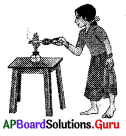
A) Plastic test
B) Flame test
C) Polymer test
D) None
Answer:
B) Flame test
Question 48.
The first rayon factory in India was established in …………. in 1946.
A) AP
B) Tamil Nadu
C) Kerala
D) MP
Answer:
C) Kerala
Question 49.
The creator of first manmade plastic is
A) Alexander Grahambell
B) Alexander Parkes
C) Alexander Dumas
D) Alexander Phillip
Answer:
B) Alexander Parkes
![]()
Question 50.
Thermoplastics are invented by
A) Hermann Staudinger
B) Marconi
C) J.L. Baird
D) Einstein
Answer:
A) Hermann Staudinger
Question 51.
………….. is considered as the father of the present plastics industry.
A) Dr. Baekeland
B) C.V. Raman
C) J.C. Bose
D) Blaise Pascal
Answer:
A) Dr. Baekeland
Question 52.
Polymers are long chain molecules was demonstrated by
A) Staudinger
B) Baekeland
C) Parkes
D) Baumann
Answer:
A) Staudinger
Question 53.
Which of the above not suitable to prepare aprons?
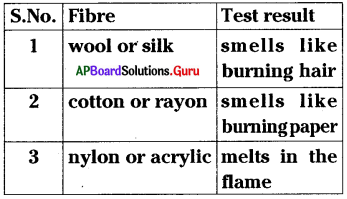
A) wool
B) cotton
C) nylon
D) rayon
Answer:
C) nylon
![]()
Question 54.
The given data belongs to
- it was first fully processed synthetic fibre.
- it became popular in second world war.
- it is prepared from coal, water and air.
A) Acrylic
B) Nylon
C) Rayon
D) Polyester
Answer:
B) Nylon
Question 55.
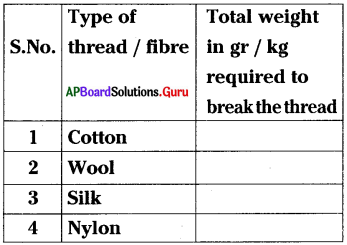
In one lab activity the observations obtained are 600 gr, 1600 gr, 500 gr, 400 gr.
If you fill these observations in the given table, S.No. 4 filled with
A) 600 gr
B) 1600gr
C) 500 gr
D) 400 gr
Answer:
B) 1600gr
Question 56.
The given label was found on a garment.
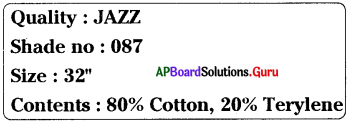
The cloth is made with
A) natural fibre
B) synthetic fibre
C) both A and B
D) none
Answer:
C) both A and B
![]()
Question 57.
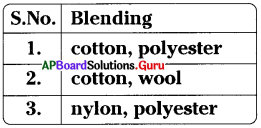
Which of the above blending fibre gives both wrinkle free and water absorbant?
A) 1
B) 2
C) 3
D) 1 and 3
Answer:
A) 1
Question 58.
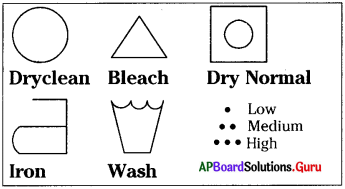
From the data the give pictures shows

A) Wash with 40°C water, do not bleach
B) Iron with low heat, do not dry clean
C) Dry normal, wash with care
D) A and B
Answer:
D) A and B
Question 59.
In a flame test the result obtained is
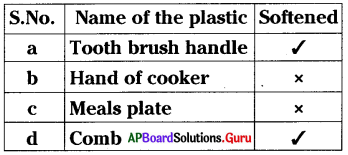
Which of the above are made with thermosetting plastics?
A) a, d
B) b, c
C) a, b
D) c, d
Answer:
B) b, c
![]()
Question 60.
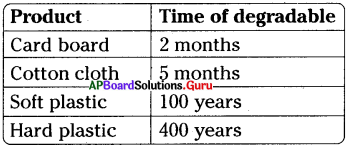
From the table which is better to use for parcels?
A) Card boards
B) Soft plastic
C) Hard plastic
D) Cotton cloth
Answer:
A) Card boards
Question 61.
From the table (above) which is degradable easily?
A) cotton
B) soft plastic
C) card board
D) A and C
Answer:
D) A and C
Question 62.
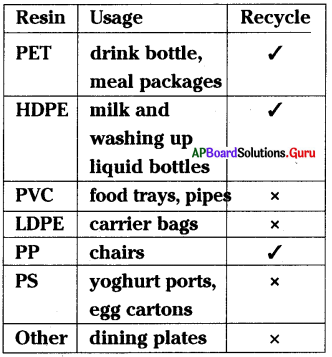
From the given table, which are usable?
A) PVC, LDPE, PS
B) LDPE, HDPE, PET
C) PET, HDPE
D) None
Answer:
C) PET, HDPE
![]()
Question 63.
If we use plastics to convert electricity it is
A) reuse
B) recycle
C) recover
D) reduce
Answer:
C) recover
Question 64.
New articles made with plastic wastage is
A) reuse
B) recycle
C) recover
D) reduce
Answer:
B) recycle
Question 65.
‘Use and throw’ encourages
A) Reduce plastics
B) Recover plastics
C) Reuse plastics
D) None
Answer:
D) None
Question 66.
If the symbol of bleach is ![]() , then symbol of do not bleach is
, then symbol of do not bleach is
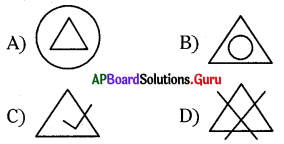
Answer:
D)
![]()
Question 67.
The diagram of resin of polyvinyl chloride is

Answer:
C)
Question 68.
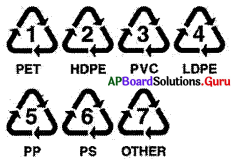
The given codes are belongs to
A) laundry codes
B) resin codes
C) blending codes
D) fibre codes
Answer:
B) resin codes
Question 69.
The combination of one or more of resins represented by
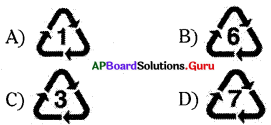
Answer:
D)
Question 70.

The figure shows
A) linear arrangement of monomers
B) cross-linked arrangements of monomers
C) circular arrangement of monomers
D) square arrangement of monomers
Answer:
A) linear arrangement of monomers
![]()
Question 71.

The figure indicates
A) Reuse
B) Recycle
C) Recover
D) Return
Answer:
B) Recycle
Question 72.
The symbol  represents …………
represents …………
A) PET
B) HDPE
C) LDPE
D) Others
Answer:
C) LDPE
Question 73.
The given fibres make us very comfortable in different situations and seasons like winter, summer, sweating, etc.
A) synthetic fibres
B) natural fibres
C) blended fibres
D) strong fibres
Answer:
C) blended fibres
Question 74.
“Synthetic fibres saves the nature” the best reason is
A) man does not depend on animals for fibre
B) man does not depend on factories for fibres
C) man does not depend on plants for fibres
D) A and C
Answer:
D) A and C
![]()
Question 75.
Very useful ‘fake fur’ is
A) nylon
B) polyester
C) acrylic
D) rayon
Answer:
C) acrylic
Question 76.
If fire catches to a person, which of the following is better to use to cover over him and to put off fire.
A) nylon cloth
B) cotton cloth
C) polyester cloth
D) acrylic cloth
Answer:
B) cotton cloth
Question 77.
The given fibres revolutionalized the fabric industry and changed the costume culture
A) polyester
B) silk
C) nylon
D) acrylic
Answer:
A) polyester
Question 78.
Which of the following saves the nature by controlling the usage of wood?
A) Polyester
B) Plastic
C) Metal
D) Glass
Answer:
B) Plastic
![]()
Question 79.
Creator of first plastic is
A) Parkesine
B) Rayon
C) Bakeland
D) None
Answer:
A) Parkesine
Question 80.
Father of plastic is
A) Parkesine
B) Herman standinger
C) Bakeland
D) Rayon
Answer:
C) Bakeland
Question 81.
This action is harmful to animals like cows
A) Throwing of food with polythene covers
B) Throwing of plastic covers in drainages
C) Both A and B
D) Using of polythene bags in homes
Answer:
A) Throwing of food with polythene covers
Question 82.
The main reasons to avoid plastic is / are
A) It is degradable
B) It is very useful to save trees
C) It leaves harmful gases on burning
D) Above all
Answer:
C) It leaves harmful gases on burning
![]()
Question 83.
………… is the only synthetic fibre obtained from plant’s cellulose.
A) Nylon
B) Plastic
C) Rayon
D) None
Answer:
C) Rayon
Question 84.
All the winterwear nowadays is made of a synthetic fibre called
A) plastic
B) acrylic
C) nylon
D) none
Answer:
B) acrylic
Question 85.
Acrylic is generally called
A) fake fur
B) good fur
C) fibre wood
D) none
Answer:
A) fake fur
Question 86.
The handles of utensils are made up of
A) bakelite
B) melamine
C) aluminium
D) gold
Answer:
A) bakelite
![]()
Question 87.
Electrical switches are made of
A) Melamine
B) Nylon
C) Bakelite
D) Rayon
Answer:
C) Bakelite
Question 88.
T.V. cabinets are made by
A) Bakelite
B) Nylon
C) Rayon
D) Melamine
Answer:
D) Melamine
Question 89.
Rock climbers use …………. climb mountains.
A) Rayon
B) Acrylic
C) Nylon
D) Polyethene
Answer:
C) Nylon
Question 90.
………….. is often mixed with cotton to make terricot and with wool to give terriwool.
A) Polyester
B) Nylon
C) Acrylic
D) Terylene
Answer:
D) Terylene
![]()
Question 91.
Choose the correct answer.
1. Code 1 — a) HDPE
2. Code 2 — b) PVC
3. Code 3 — c) PET
A) 1-c, 2-a, 3-b
B) 1-b, 2-c, 3-a
C) 1-c, 2-b, 3-a
D) 1-b, 2-a, 3-c
Answer:
A) 1-c, 2-a, 3-b
Question 92.
Choose the correct answer.
1. Code 4 — a) PP
2. Code 5 — b) PS
3. Code 6 — d) LDPE
A) 1-b, 2-a, 3-c
B) 1-c, 2-a, 3-b
C) 1-c, 2-b, 3-a
D) 1-b, 2-c, 3-a
Answer:
B) 1-c, 2-a, 3-b
Question 93.
Kitchenware is made of …………
A) nylon
B) bakelite
C) melamine
D) polyester
Answer:
C) melamine
Question 94.
We are using plastic everywhere, because plastics
A) will not corrode easily
B) is very light, strong and cheaper
C) is water resistant
D) above all
Answer:
D) above all
![]()
Question 95.
Polythene is combination …………… of monomus.
A) 1
B) 2
C) 3
D) many
Answer:
D) many
Question 96.
Synthetic fibres are synthesized from raw material called
A) steel
B) metals
C) glass
D) petroleum
Answer:
D) petroleum
Question 97.
Like synthetic fibre, plastics also ………….
A) monomer
B) dimer
C) trimer
D) polymer
Answer:
D) polymer
Question 98.
A silk fibre’s smooth surface absorbs light.
A) yes
B) no
C) can’t say
D) none of these
Answer:
A) yes
![]()
Question 99.
Choose correct matching option.
Group – A — Group – B
1. Thermosetting — a) Plastic plastics
2. Thermoplastic — b) Bakelite
3. Biodegradable — c) Acrylic
4. Non-biodegradable — d) Food
5. Artificial wool — e) Polyethene
A) 1 – b, 2 – e, 3 – d, 4 – a, 5 – c
B) 1 – a, 2 – b, 3 – c, 4 – d, 5 – e
C) 1 – b, 2 – c, 3 – d, 4 – e, 5 – a
D) 1 – c, 2 – d, 3 – e, 4 – a, 5 – b
Answer:
A) 1 – b, 2 – e, 3 – d, 4 – a, 5 – c
Question 100.
Ropes of nylon fibre can be used as nets for fishing due to
A) elastic property
B) light weight property
C) water proof property
D) above all
Answer:
D) above all
Question 101.
These fibres absorbs water
A) nylon
B) rayon
C) polyester
D) above all
Answer:
B) rayon
Question 102.
Strong, elastic, light weight, water proof and cheaply available ropes are
A) nylon ropes
B) jute ropes
C) cotton ropes
D) rayon ropes
Answer:
A) nylon ropes
![]()
Question 103.
Sanitary product diaper is made with
A) nylon
B) cotton
C) rayon
D) wool
Answer:
C) rayon
Question 104.
Ropes of parachutes not made with rayon because
A) rayon absorbs water
B) rayon catches fire
C) rayon is more cost
D) above all
Answer:
A) rayon absorbs water
Question 105.
Generally umbrellas are made with
A) nylon
B) rayon
C) cotton
D) acrylic
Answer:
A) nylon
Question 106.
Handles of kitchen ware made with
A) thermo plastics
B) thermosetting plastic
C) both
D) nylon
Answer:
B) thermosetting plastic
![]()
Question 107.
Assertion (A): Bakelite is used for making handles of various cooking utensils.
Reason (R): Bakelite is good conductor of heat and electricity.
A) A and R are true and R supports A
B) A and R are true and R does not support A
C) A is true but R is false
D) A is false but R is true
Answer:
C) A is true but R is false
Question 108.

The given articles are made with
A) Bakelite
B) Melamine
C) Nylon
D) PET
Answer:
A) Bakelite
Question 109.

The given articles are made with
A) Bakelite
B) Melamine
C) Nylon
D) PET
Answer:
B) Melamine
Question 110.
Which of the following is not a synthetic fibre?
A) Acrylic
B) Nylon
C) Wool
D) Polyster
Answer:
C) Wool
![]()
Question 111.
1) Rayon is also called cellulose fibre
2) Acrylic is also called fake fur Choose the correct answer.
A) 1 – True, 2 – True
B) 1 – True, 2 – False
C) 1 – False, 2 – True
D) 1 – False, 2 – False
Answer:
A) 1 – True, 2 – True
Question 112.
The resin identification code that indicates (HDPE) High Density Polyethylene is


Answer:
B)
Question 113.
P: Nylon is the first synthetic fibre.
Q: Nylon is thermosetting plastic.
A) P – true, Q – true
B) P – true, Q – false
C) P – false, Q – true
D) P – false, Q – false
Answer:
B) P – true, Q – false
Question 114.
A plastic piece is burnt on spirit lamp by holding it with a holder. The plastic piece was softened and melted. What do we determine by this activity ?
A) The recyclable plastic
B) biodegradable plastic
C) Thermo Plastic
D) All of the above
Answer:
C) Thermo Plastic
![]()
Question 115.
What are the steps taken by you by knowing the impacts of improper use of plastics on environment?
i) will reduce the utilization of plastic
ii) Plastic wastage is sent to waste management industries
iii) I suggest only recyclable plastic
iv)I will nature the people aware on impact of plastic on environment
A) ii and iii only true
B) iii and iv only true
C) i, ii, iii and iv true
D) i and ii only true
Answer:
C) i, ii, iii and iv true
Question 116.
What is the suggestion made by you to your mother while she is cooking by knowing differences between natural and synthetic fibres ?
A) I suggest her to wear polyster made clothes.
B) I suggest her to wear Acrylic made clothes.
C) I suggest her to wear cotton made clothes.
D) I suggest her to wear Nylon made clothes.
Answer:
C) I suggest her to wear cotton made clothes.
Question 117.
Symbol below indicates

A) Reuse of plastic
B) Recover of plastic
C) Recycle of plastic
D) Reduce of plastic
Answer:
C) Recycle of plastic
![]()
Question 118.
Abhishek wanted to know what are thermoplastics and thermosetting plastics, materials in his home. He was testing small pieces of plastic materials by heating on spirit lamp. Which precaution will he take during the experiment?
A) Wears Nylon clothes
B) Covers his nose and mouth with mask
C) Keeps close to spirit lamp
D) Sample plastic holds with hands
Answer:
B) Covers his nose and mouth with mask
Question 119.
Suneetha tested tensional strength of wool, cotton, silk and Nylon, whose having same measurements. Which of the following fibre more strength?
A) Cotton
B) Nylon
C) Wool
D) Silk
Answer:
B) Nylon
Question 120.
Match the fibres given in Set I with their properties in Set II.
Set I — Set II
i) Nylon — a) Fake fur
ii) Rayon — b) Natural fibre
iii) Acrylic — c) Artificial silk
iv) WooI — d)First processed synthetic fibre
A) i – c, ii – a, iii – d, iv – b
B) i – d, ii – c, iii – a, iv – b
C) i – b, ii – a, iii – c, iv – d
D) i – a, ii – d, iii – b, iv – c
Answer:
B) i – d, ii – c, iii – a, iv – b
Question 121.
“Yaswanth tested the yarn of different fibres. He observed that the yarn melts in the flame.” Predict which fibre melts in flame.
A) Cotton or Rayon
B) Nylon (or) Acrylic
C) None
D) Wool or silk
Answer:
B) Nylon (or) Acrylic
![]()
Question 122.
Your father brings water pipe from market. You observed symbol on it. Which type of plastic is used to make it?
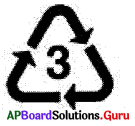
A) PET
B) PS
C) PVC
D) HDPE
Answer:
C) PVC
Question 123.
Identify the characteristics of Nylon.
i) Nylon fibre is strong
ii) Elastic
iii) Light weight
iv) Absorb water
A) i, ii and iii only true
B) ii and iii only true
C) iii and iv only true
D) i and ii only true
Answer:
A) i, ii and iii only true
Question 124.
P: Thermoplastic which will soften when heated
Q: Thermosetting plastics are not re- mouldable
A) P is True and Q is False
B) P & Q are False
C) P is False & Q is True
D) P and Q are True
Answer:
D) P and Q are True
![]()
Question 125.
Which of the following is the closest reason for preserving acids in plastic bottles?
A) plastic is very light
B) plastics are non-reactive
C) plastic is strong
D) plastics are cheaper than metals
Answer:
B) plastics are non-reactive
Question 126.
Which of the following is a thermo-setting plastic?
i) Bakelite
ii) Melamine
iii) Polythene
iv) PVC
A) ii and iii only true
B) i and iii only true
C) i and ii only true
D) i and iv only true
Answer:
C) i and ii only true
(127 – 128)
| Type of Fibres | Character |
| Nylon | Strong & Doesn’t absorb water |
| Cotton | Absorbs water |
| Wool | Heat Resistant |
From above information answer these
Question 127.
Which clothes do you wear in summer?
A) Cotton made
B) Wool made
C) Polyester clothes
D) Nylon made
Answer:
A) Cotton made
![]()
Question 128.
Why nylon is used to make parachute?
A) Nylon is attractive fibre
B) Nylon is strong
C) Nylon is soft
D) Nylon creates static electricity
Answer:
B) Nylon is strong
Question 129.
Nylon : Synthetic fibre :: …………….. : Cellulose fibre
A) Rayon
B) Acrylic
C) Polyester
D) Silk
Answer:
A) Rayon
Question 130.
Which of the following is/are thermosetting plastic?
i) HDPE
ii) LDPE
iii) Bakelite
iv) Melamine
A) Only (iii)
B) (i) & (ii)
C) (iii) & (iv)
D) Only (iv)
Answer:
C) (iii) & (iv)
Question 131.
“Universal recycling symbol is chasing arrows. Inside the arrows there will be a number that indicates the polymer”. If a synthetic material is said to be recycled, the code in the icon would be
A) Code – 4
B) Code – 2
C) Code – 5
D) Code – 3
Answer:
B) Code – 2
![]()
Question 132.
Shobhan planned to visit Kashmir along with his parents. What types of clothes would he buy to his parents?
A) Silk
B) Cotton
C) Wool
D) Polyester
Answer:
C) Wool
Question 133.
Which of these statements about acrylic is wrong?
A) It become commercially available from 1941
B) It is made from a combination of coal, air, water, oil and limestone
C) Acrylic is more expensive than natural wool
D) It is commonly known as fake fur
Answer:
C) Acrylic is more expensive than natural wool
Question 134.
In “Identification of fibres – Burning test” activity what are the precautions to be taken.
A) Yarn should be burnt by maintaining a minimum distance to the flame
B) Yarn should not be burnt by keeping them in hands
C) We should not smell the smoke
D) All the above
Answer:
D) All the above
Question 135.
Which types of clothing is MOST suitable for wearing in very cold hill station?
A) Loose silk clothes
B) Thick woollen clothes
C) Tight polyester clothes
D) Thin cotton clothes
Answer:
B) Thick woollen clothes
![]()
Question 136.
Which of the following is known as ar-tificial silk?
A) Rayon
B) Acrylic
C) Nylon
D) Wool
Answer:
A) Rayon
Question 137.
Plastics which moulded once cannot be softened by heating are called
A) PET
B) Biodegradable plastics
C) Thermoplastics
D) Thermosetting plastics
Answer:
D) Thermosetting plastics